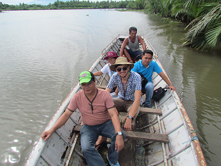
Reported by Linley Wilkie

Image: Michael Arman
Michael Arman: 2012 Young Planner of the Year.
When Michael Arman was a teenager, he was fascinated by spaces and places, from the tiny rural towns his family would visit during road trips, to Australia’s capital cities, including his hometown of Adelaide. Then in Year 12, he had a geography teacher who challenged the processes that inform the ways cities run, the ways communities work and the ways the environment is managed. By then his enthusiasm for geography was so ingrained, it was only natural for him to follow a career path that allowed him to extend that knowledge. For Arman, planning was the natural extension, taking the principles of geography and applying them to real world communities and places.
Fast forward to the present day and 24-year-old Arman is living in the Philippines, working with the municipal government of Canaman in its planning and development office. As part of the Australian Volunteers for International Development program, Arman’s year-long relocation comes hot on the heels of being crowned Young Planner of the Year by the Planning Institute of Australia. Arman couldn’t have planned it better.
The national award followed his win as South Australia’s Young Planner of the Year, the judges commenting that, “Michael impresses as a Young Planner who has exceptional qualities, demonstrated through his academic achievements, his breadth of involvement across the range of planning disciplines, engagement with the community and contributions to planning.”
Honoured by the accolade, Arman says it draws attention to the importance research plays in planning. “In the different roles I’ve taken at URPS and also as a researcher at UniSA and even in the Philippines, my role has always had a stronger focus on research and trying to understand what all the research trends are telling us and what that means for the future.”
Arman studied Urban and Regional Planning at the University of South Australia, where he won multiple awards for his studies, including the university’s School of Natural and Built Environment’s prize for Best Undergraduate Planning Student. Arman continued his research for the university post graduation and worked at Adelaide-based urban and regional planning consultancy firm, URPS. His personal interests have always complimented his professional pursuits, including his volunteer work for Trees for Life, the Australian Youth Climate Coalition and tutor work for the Australian Refugee Association.
Arman’s work in the Philippines allows the Canaman planning office staff time to take a longer-term view of development, given there is normally only one person assigned to planning. “The project that I’m involved in as an extra resource means we’ve got the ability to press pause for a second and start to think a little bit long term about not just urban growth, but climate change, natural disasters, and that’s really important for the community,” Arman says.
“The Philippines is very good at the nuts and bolts of emergency planning and evacuation drills. But I think the real gap is around longer term planning and thinking about some of the longer term trends. We know what the current trends and natural disasters are, but there hasn’t been a lot of thought yet about how these trends are changing with climate change.”

Image: Michael Arman
Michael Arman running a workshop with Canaman municipality staff.
Arman says planning has always played an important role in reducing community exposure to risks.
“While many people think about reducing exposure to physical risk, for example, preventing people from living in areas known to experience bushfire or flooding, or rebuilding after an earthquake, planning also plays a role in shaping the formal and informal networks in a community,” he says. Arman adds that networks, be it an informal connection between neighbours, or a more formal organisation, are critical to successfully preventing, preparing for, responding to and recovering from emergencies.
“Good planning can foster these networks by ensuring all communities have equitable access to the services and institutions they need.
“Thoughtful and carefully planned neighbourhood design and layout and on-the-ground community development also makes it easier for people to get to know each other,” he says.
A passionate environmental advocate, Arman says climate change and the increasing uncertainty about the nature and magnitude of emergencies and disasters, means planning will be critical due to its role in supporting and strengthening networks within the community. “In addition to the traditional planning process focused on reducing exposure and risk to known disasters, the role of planning in fostering these connections and networks will become more important due to the increasingly unforseen nature of disasters and emergencies. It also puts people, not plans or institutions, at the centre of our thinking about emergencies, risks, disaster and climate change, which is where the most effective change is likely to occur.”

Image: Michael Arman
Michael Arman on a boat with Canaman municipality staff, visiting one of the ‘island’ barangays (villages).